A lifelong walk to the same exact spot
Someday you will die somehow, and something's gonna steal your carbon
Whenever I slip toward despair, I take comfort from a 2022 image captured by the James Webb Space Telescope. Through a window of space no larger than a grain of sand, the view reaches toward the edge of the known universe as it appeared near the beginning of time, 13.5 billion years ago. It’s the astronomical equivalent of standing on top of the tallest mountain on the clearest day and looking toward the farthest horizon. In a tiny burst of 13.5-billion-year-old light, the image captures thousands of distant galaxies, the formation of stars and their white-flash deaths, black holes devouring matter, galaxies stretching and pulling away from each other, vast reaches of space and time. The image is unfathomably beautiful. I look at it and think, “The carbon made by these stars is the carbon I carry in my body. It doesn’t belong to me. I belong to the universe.”
I think of our one fundamental truth: “Everything changes.”
And I think of Carl Sagan, 20th-century pop culture astronomer of “we are made of starstuff” fame, and my favorite writings of his:
“Look again at that dot. That's here. That's home. That's us. On it everyone you love, everyone you know, everyone you ever heard of, every human being who ever was, lived out their lives. The aggregate of our joy and suffering, thousands of confident religions, ideologies, and economic doctrines, every hunter and forager, every hero and coward, every creator and destroyer of civilization, every king and peasant, every young couple in love, every mother and father, hopeful child, inventor and explorer, every teacher of morals, every corrupt politician, every "superstar," every "supreme leader," every saint and sinner in the history of our species lived there — on a mote of dust suspended in a sunbeam.”
This week, I’ve rediscovered the soothing power of the long ride. It’s an effortless flow that I keep trying to force out of my running, because running is so versatile and can take me across all kinds of terrain, and because running doesn’t require a symbiotic relationship with a finicky mechanical object. But running doesn’t come naturally to me. I’ve always known and almost accepted this uncomfortable truth. The simple act of one foot in front of the other is a fight with my brain, demands constant focus, and frequently results in small but meaningful violence. I fall. I get injured. Pain persists in all of the little ways I’ve nursed injuries for the majority of my running “career” — my most recent being a muscle tear in my shin that still pings and wakes me up at night.
Cycling, on the other hand, just fits. I can straddle almost any bicycle within reason and ride for hours. The greater distances provide expansive views. The motions of steering and pedaling are almost automatic, and my body seems to instinctively know when to take in calories and where to distribute energy. I can ride for hours, days, even weeks without excessive fatigue or pain. I drift into flow state, moving slowly through the world and instantaneously through the vast reaches of space and time.
I think the main reason I resist spending all of my free time pedaling is that I don’t necessarily get to choose where I go. My pursuit of flow state requires strenuous efforts on predictable surfaces. The terrain I ride is admittedly dull, such as dirt-road climbs or smooth trails, or dangerous, such as gravel and paved roads shared with cars. I become frustrated with mountain biking on technical terrain because it continuously rips me out of flow state and threatens more serious violence than hiking and running. But my heart — if not my brain — craves exciting terrain and farther reaches of exploration, so I turn to hiking and running.
It’s a conundrum when it shouldn’t be. As I move closer to joining my heart and mind rather than fighting both, I find what I need: Space. Sometimes it’s the upper reaches of a mountain, grasping rock with my hands. Sometimes it’s a winding ribbon of rocky singletrack where I can release my inhibitions and run as though I’m dancing. And sometimes it’s an all-but-forgotten stretch of sandy doubletrack through the woods, grinding pedals over loose dirt. The key, as always, is knowing when to let go and fly.
Flow-seeking originates at the core of our humanity. But at the same time, it feels like a temporary escape from the difficulties of being human. The escape has felt more necessary as I grapple with surges of strong emotion that seem to arise out of nowhere.
The anger and despair come from the acts of humans. And it seems my brain is projecting the equally strong contrast of these emotions onto animals. When I catch a glimpse of the elk herds, I feel a strong desire to join them, to run with them into the hills, if only they would accept me. I’m in love with the turkeys strutting and posturing ridiculously in front of my car, the mule deer with their dopey facial expressions, the bobcat growling at our Ring camera.
Last week, while visiting my friend Betsy, I fell in love with a little dog that belongs to her 80-year-old mother-in-law. The dog is a cute little terrier type, a bit bow-legged, with the softest fur I’ve ever felt. I learned that she is a rescue who was pregnant when the mother-in-law found her and helped rescue all of the puppies as well. I nearly broke into tears, such was my sudden surge of affection. And I immediately found this emotion funny because I am not a dog person. I had three traumatic experiences in my youth — bites from two different neighborhood dogs at ages 8 and 10, and one full attack that was reasonably severe while hiking in Maine at age 21 — that cemented a deep fear and distrust of all dogs. Only in recent years, thanks to the frequent exposure one can’t help but have when they live in a place like Boulder, have I grown to at least trust dogs and not panic when they approach me. But to fall in love with a dog? To feel such emotion even for a small, quiet, clearly harmless dog, is such a massive leap for me! I thought perhaps “Bridgerton” reminded me of my childhood pet, an unconditionally loving cocker spaniel named Callie. Or perhaps I’m just projecting again …
The issue came to a head on Sunday night when a strange creature strolled in front of our back-porch Ring camera in a cold rain that preceded 2 inches of snow. The camera fell over in a recent wind gust and is currently sitting on the ground, but I didn’t know this when I first watched the motion-capture video. From the height the camera should be at, this creature appeared huge. Some sort of desert lizard, I thought — a monitor or a gila monster — likely a non-native that isn’t meant to be stranded in a snowstorm at 7,200 feet in Colorado. The thought of this poor creature shuffling into the cold night to die filled me with rage. I convinced myself it was a pet that somebody abandoned. What person could be so evil? Was it one of my neighbors? What could I do? Could I find it after eight hours had gone by? Could I live-trap it? The anger and concern gnawed at me until I cracked and posted the video on Facebook. As much as I am trying to avoid social media, I concede that hive mind is still a useful source of information.
The consensus from expert friends — actual biologists — was that it’s a tiger salamander, which is native to Colorado. It’s the state amphibian! They can survive long, frigid winters, even freezing over and returning to life in warmer temperatures. They tend to spend most of their time burrowed in the ground, but migrate to breeding grounds in the early spring. This is probably why I’ve never seen one before. I was so relieved! But I also had to question the source of my boiling anger toward nonexistent humans and their imagined responsibility for a creature I couldn’t even identify. Clearly, I have some issues to work through.
My Alaskan friend Corrine came to town this week for a short visit to spend time with Betsy. She’s preparing for a long ride across the Lower 48 starting in June. For this endeavor, I am (somewhat) envious. How great would it be to spend one or two months just riding my bike, eating and sleeping, ignoring the news, being blissfully self-centered, using every bit of economic and health privilege I have to escape? A weeks-long bike escape is, alas, not what I need right now. Beat and I are approaching a transitional part of life, and it’s not the time to defer the issues we need to address. It also feels like the wrong time to look away from everything that’s happening. If I’m one of the luckier ones, someday this will all be part of a story I will want to tell. I need to pay attention. I need to prepare.
But I am excited for Corrine. She’s worked hard as a family physician for decades to earn this slice of retirement. She’s fit and healthy at 66. These are gifts not to be squandered.
Meanwhile, I’ve been dragging my feet on my Lexapro taper. I’m due to cut my dose in half again, but I’ve been reluctant. I still feel emotionally stunted, but the bursts of passion that have come through in recent weeks have been unnerving — this weird thing with animals, and the anger. Anger is not part of my normal. What happens if it all comes out? I’m grieving what’s happening to my country, clearly in the anger stage, and genuinely concerned about what will happen if the dam of emotion bursts.
But is it better to be blissfully detached? I’m not even sure it’s the drug that’s put me in this trance. Lexapro was a brain balm that I used without issue for nearly two years before something broke after I came down with Covid in late January. My ever-present anxiety — which the drug quieted, but didn’t eliminate — was suddenly gone. For the first few weeks, I thought this odd brain change that freed the anxiety monster was great, everything I’d ever wanted. But then I realized I was also free of grief, free of elation, free of anticipation, free of concern, free of joy. I was free of most of the emotions that fill the human experience. I acknowledged that this is not what I want.
Maybe I should also go easy on my renewed desire to spend every free waking hour on my bike. It’s wonderful to float through space, but there’s merit to enduring the gravity of Earth.
So I’m back to running. I signed up for a 40-mile trail race in the Napa Valley on May 17 … which, what can I say? Beat needs to travel to the Bay Area for work again, and I’ll take any opportunity to float through the nostalgia of my halcyon years in California. Also, these mid-distance trail races have proven to be such fun. Why make more excuses? But I will need some fresh conditioning. I’m built for the bike, but I’ve never been able to fake an effort on foot.
Also, I’d like to visit my Dad — by which I mean hike to the places where we spread his ashes in Canyonlands National Park — before the heat of summer fully clamps down. Now that my May calendar is full with a trip to London with my mom and sisters, this trip to California, and jury duty, I started to think about next weekend — just days before the London trip. The weather looks amenable. I’m done with my many April appointments and friend visits. Can my body handle it? I’m feeling uncharacteristically optimistic.
Today, after several days of windy red-flag fire danger and T-shirt weather, the snow returned to Colorado. So I returned to running. If you can call slogging through four inches of spring sludge “running.” I felt fantastic. My shin never complained. The beautiful flakes fell, coating the fresh colors of spring in winter shades of gray and white.
I wish the snow would stay. Summer is difficult for me — a season of physical breakdown (allergies, air pollution, and asthma) and mental wounds (my most affecting traumas are anchored in the late spring and summer months). But this is why I want to be strong. Even if it means reconnecting with anxiety as well as grief and anger. I want to meet the future with a clear head and clearer purpose. Gazing into the incredibly distant past is where I find peace, but the future is where I find meaning. Even if I share no part of that future, this world I love will. And in turn, among the elements of the universe, so will I.
Everything changes.




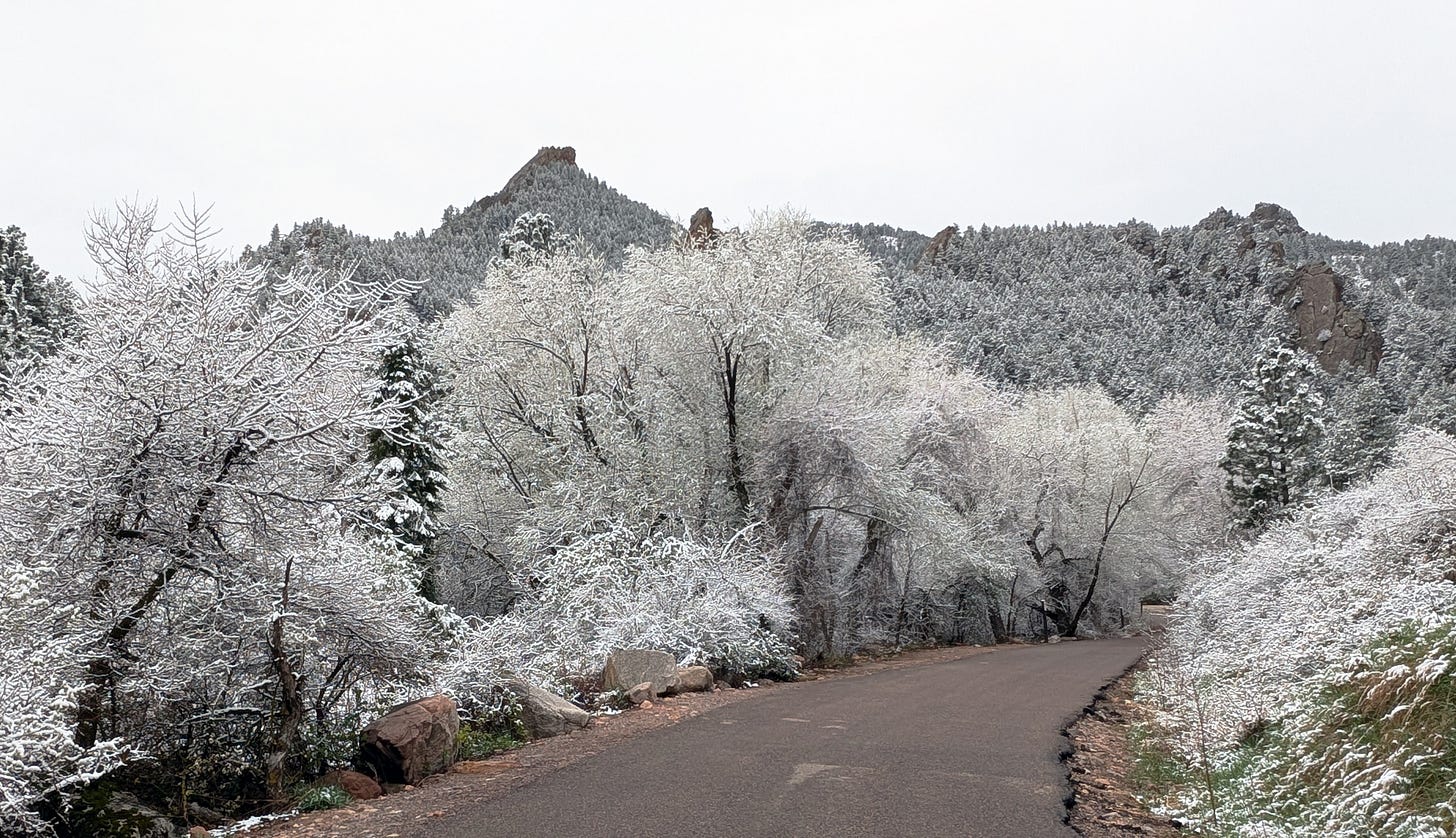
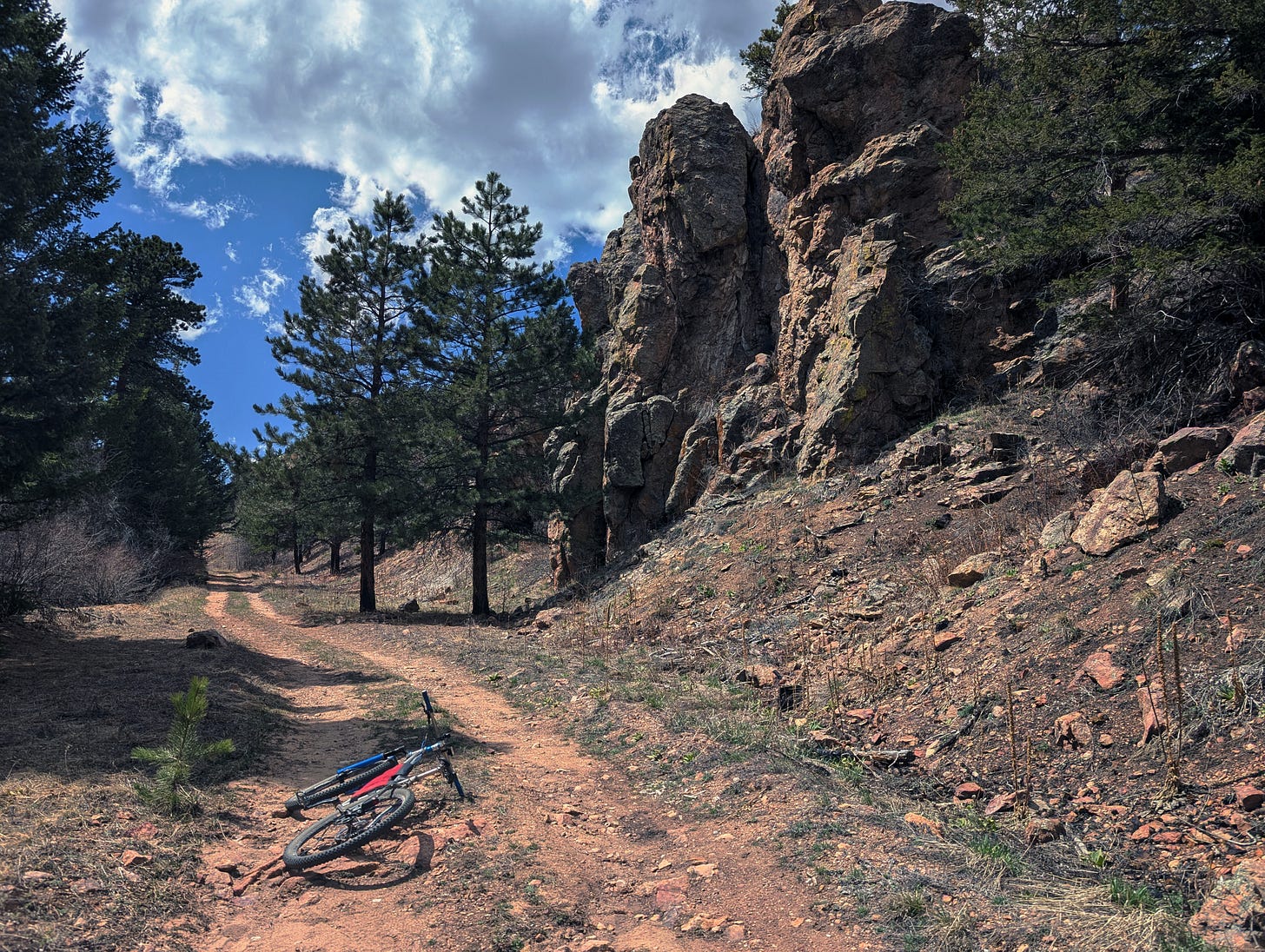
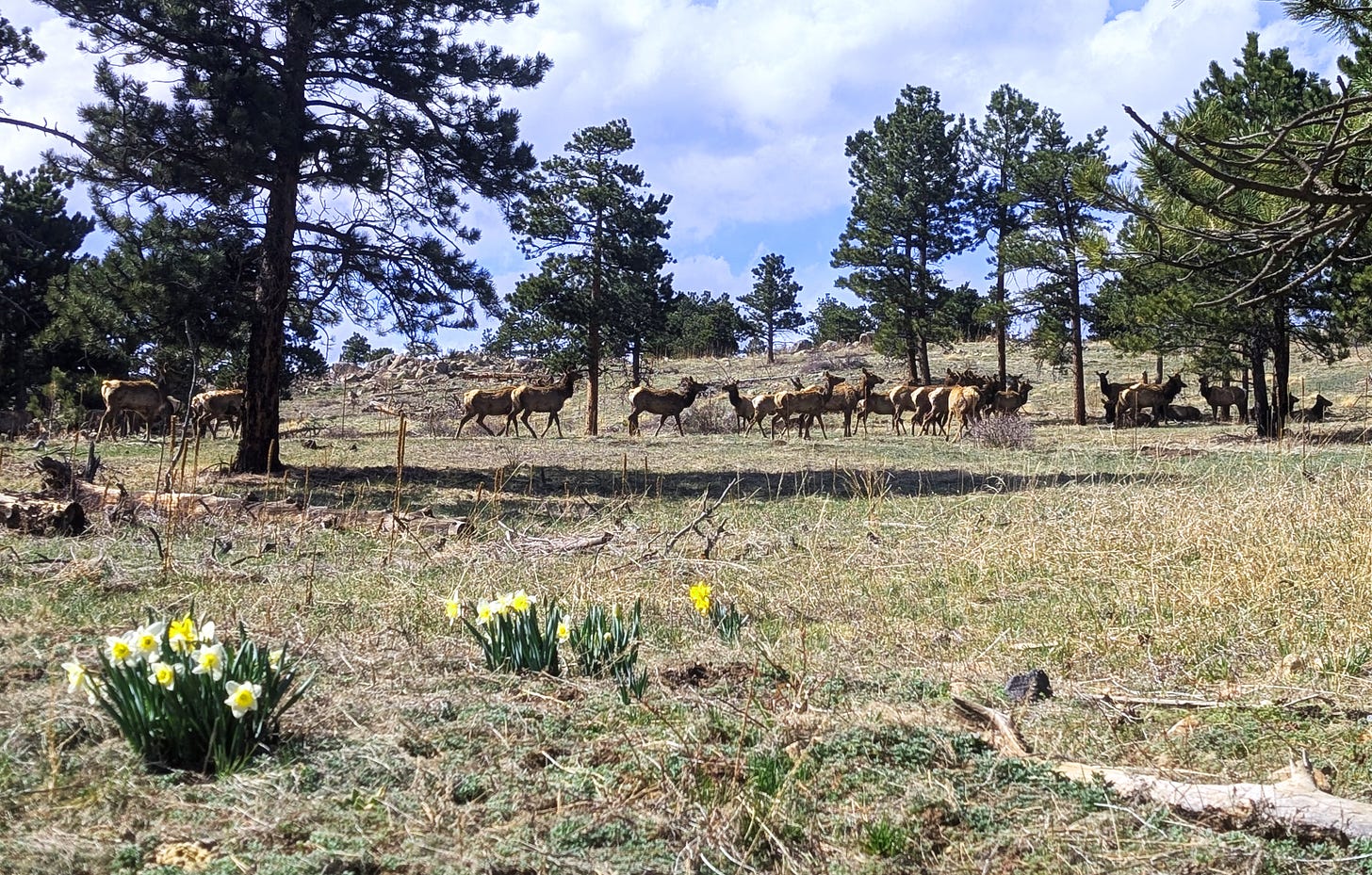

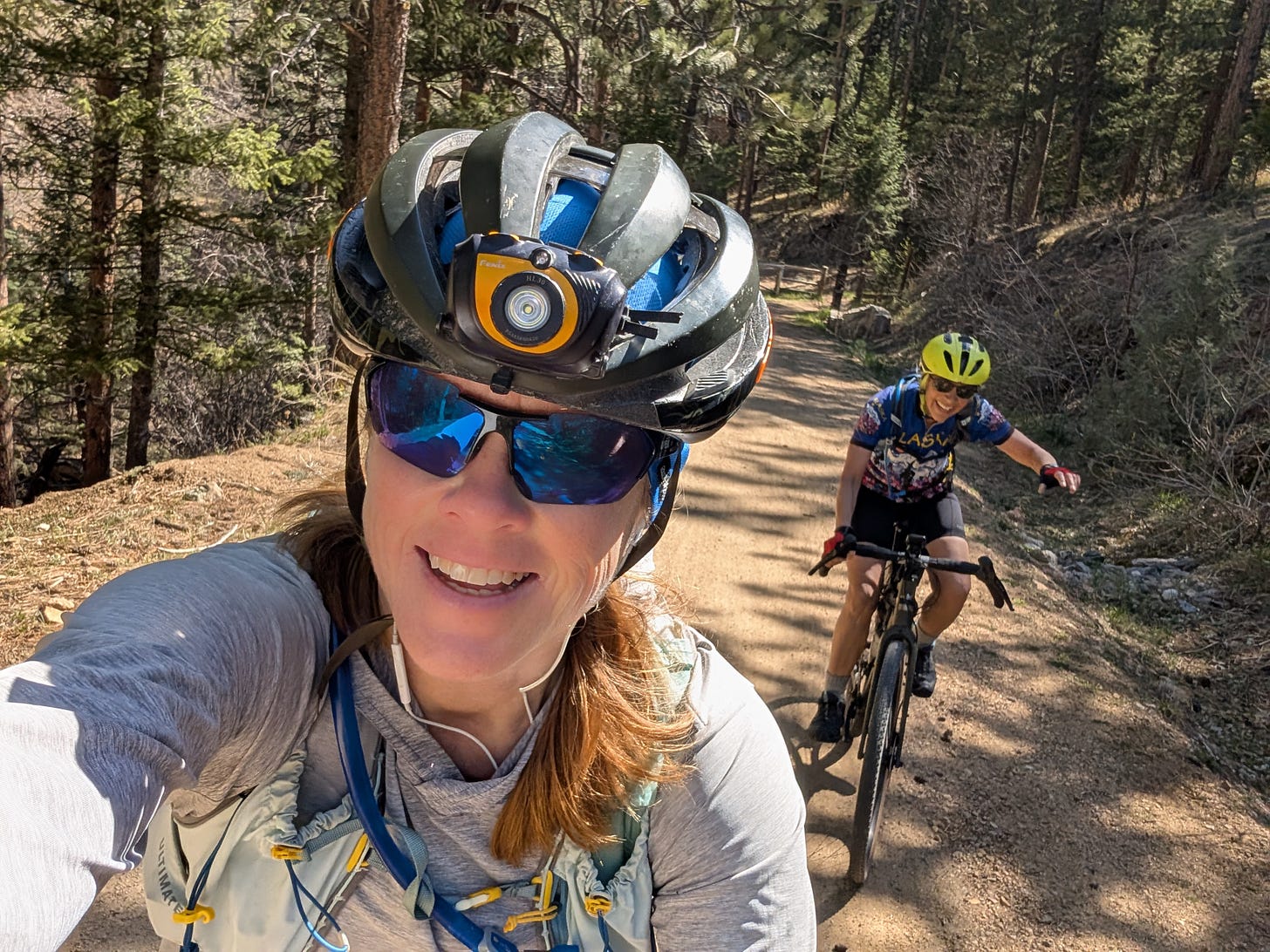
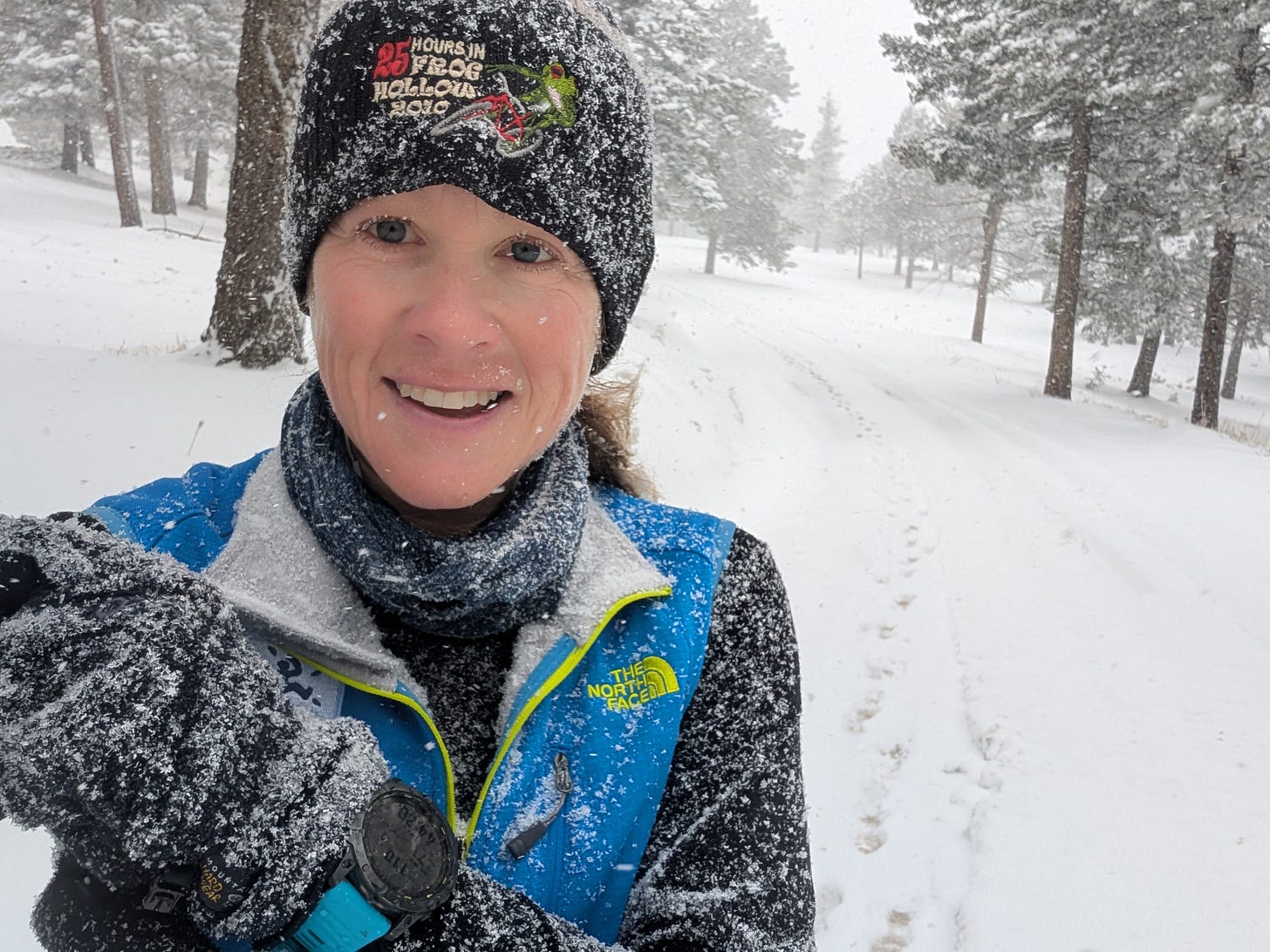
Seems like forever since I’ve read one of your writings and as always it has motivated me to get out there more. I currently have a new torn posterior tibial full tendon tear that I am dealing with. For months my limit to hiking has been 3 miles. If I can learn to live with the discomfort and strengthen everything around it I might be fine to hike rougher terrain and more miles. Surgery is a 12-18 month recovery and there would still be discomfort after. The doc said she would need to break my heal. So,as of now there will be no surgery. This is just one more big bump in the road for me. It’s time to get out my recumbent to test how my ankle will do cycling. Thanks so much for sharing your challenges and successes. Godspeed to you once again as you train for a mid-mile race.
Truly appreciate your musings Jill. Few people wish for summer to pass and winter to stay!